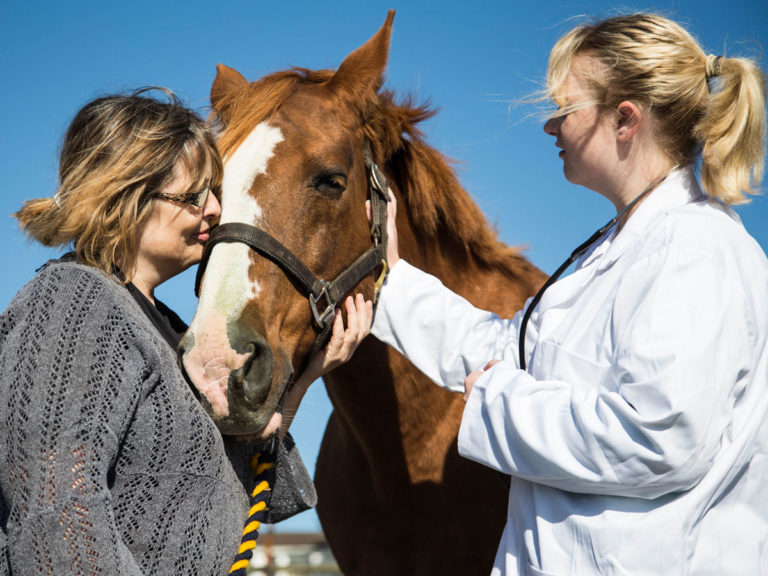
A 2021 equine herpesvirus type 1 (EHV-1) outbreak in Pennsylvania was found to be caused by a new H752 genotype. Nichola Pusterla, DVM, PhD, DACVIM, DAVDC-Equine, talked at the 2021 AAEP Convention about discovering the new equine herpesvirus type 1 (EHV-1) genotype. He also discussed what practitioners and researchers can learn from an outbreak.
Editor’s Note: The 2022 AAEP Convention coming up fast . We know how hard it is to get to all of the talks you want to hear each year. Therefore, EquiManagement and Zoetis have partnered to bring you short summaries from selected 2021 AAEP Convention presentations! Whether you missed these presentations or table topics or you just would like to listen to the presenters speak on the topics again, we invite you to tune in for all of these podcasts.
“The important part of an outbreak is that we can learn something,” said Pusterla. “This outbreak was unique in that two veterinarians were doing routine dentals at a show barn. They took rectal temperatures and found 10 [horses] were elevated. Those horses were bright and eating, but that started the investigation.”
He and his team found through testing that the molecular pattern of the Pennsylvania EHV-1 horses didn’t fit with other herpesvirus outbreaks.
Check Horse Temperatures
Pusterla emphasized the importance of daily monitoring of high-risk horses such as those traveling to shows or events. He especially recommended taking rectal temperatures twice daily.
“It’s a very powerful diagnostic tool,” he said. This could help catch equine herpesvirus type 1 (EHV-1) cases sooner.
“In the past 15 years [when there’s a fever in a show horse], we assume it is EHV-1,” Pusterla explained. “The non-neurologic genotype being N752 and neurologic being D752. This is defined by amino acids in a specific gene,” Pusterla explained. They found H752, a “histidine,” during the Pennsylvania EHV-1 outbreak. “If you only test for N or D, you would not find H,” he added.
Pusterla said that in the 2021 outbreak, 31 horses were sick. However, none had severe neurologic signs associated with equine herpesvirus myeloencephalitis (EHM).
Equine Herpesvirus (EHV-1) Recap
Pusterla reminded the audience that EVH-1 usually causes a self-limiting, upper airway infection. “Like kids at day care,” he explained.
There also can be cases of abortion or the neurologic form (EHM). He noted that there is a lot of research and clinical emphasis on how to prevent the neurologic form and how to treat it. Pusterla said there is little scientific data supporting treatments at this point.
He said when a horse spikes a temperature, it should be isolated until it is determined what is causing the fever.
Neurologic Equine Herpesvirus
Pusterla reminded veterinarians that he used to think knowing if the herpesvirus genotype was neurologic (D752) or non-neurologic (N752) was relevant to predicting severity of a disease or outbreak. However, now he is sure that isn’t the case.
“The outbreak in Ogden, Utah, was neurologic type,” he said. “In Spain it was non-neurologic type. California was non-neurologic.
“All genotypes can cause neurologic disease,” he stressed.
Pusterla said that veterinarians should treat all EHV-1 strains as if they can cause neurologic disease.
Risk Assessment for EHV-1
Pusterla said he would like to be on the team that researches how to assess the risk of a herpesvirus outbreak. He noted that show managers, horse owners and veterinarians all want to understand how to reduce disease—especially neurologic disease—and deaths due to equine herpesvirus type 1 (EHV-1).
“We are behind in the equine industry for risk assessment,” said Pusterla. “We are reactive rather than pro-active.”
He wants to look at risks such as:
- Time of year
- location
- density of horses
- type of event
- what else was reported
Then he said researchers could create an algorithm to help veterinarians, show managers, trainers and horse owners know which are low-risk or high-risk situations.
“We need to capture the metrics,” he emphasized. “Models work. We’re in the stone-age here.”
For example, Pusterla said to take the situation where a horse has a fever. By the time a veterinarian diagnoses the cause, it could be 5-10 days later. During that time there can be active spread of the virus.
“We are underestimating EHV-1,” Pusterla stated. “We have to figure out how to protect your horse, how to quarantine sick horses to protect other horses, and how to get out of show grounds when there is an outbreak.”
About Dr. Nichola Pusterla
Nichola Pusterla, DVM, PhD, DACVIM, DAVDC-Equine, is a professor of equine internal medicine and dentistry at the University of California, Davis, School of Veterinary Medicine. His research focus is on equine infectious diseases with an emphasis on molecular epidemiology. Pusterla also leads the UC Davis Equine Infectious Disease Research Laboratory.
Sponsored by Zoetis.
Connect with Zoetis Equine on Instagram and Facebook









